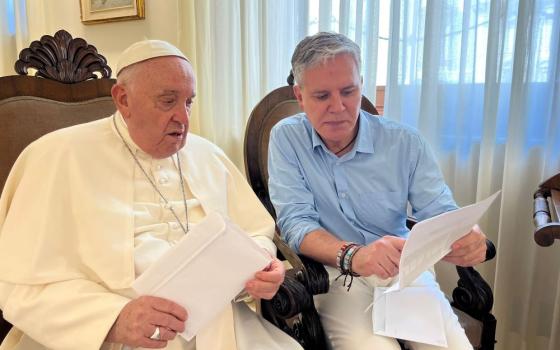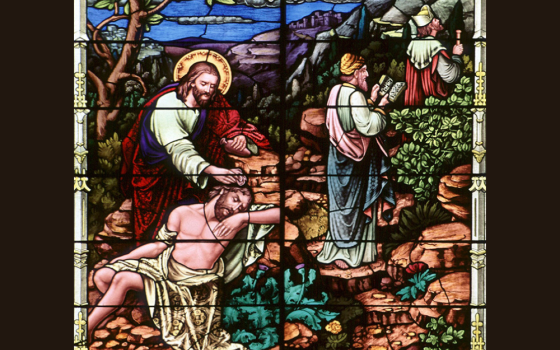
Al Green performs during the Essence Music Festival in New Orleans in this July 5, 2009, file photo. Green was 26 when "Let's Stay Together," arguably his most famous album, was released in 1972. (AP/Patrick Semansky)
Al Green was looking to get to God. The music world no different than the one occupied by all us other humans and sinners, empty and waiting to be filled or for fulfillment, whichever is found first.
Al Green, born Albert Leornes Greene, found God in the 1970s; he became a Baptist minister, preaching at the Full Gospel Tabernacle church in Memphis, Tennessee. Green continued to write and perform music, but his voice had changed: God and self-determination had rooted themselves on his tongue.
Green was 26 when "Let's Stay Together," arguably his most famous album, was released. He had been making music since he was a teenager and released three albums before the nine-track "Let's Stay Together" landed on the radio in 1972. The album exploded in popularity, winning two Grammy awards and concretizing itself as one of the best soul albums of all time.
It was the first album that highlighted what Green's voice could do: resonate the oceanic movements of my body. The hum of my heart, rhythm of my breath and slow meandering of blood through my veins collide and grab hold of each other to move my soul in the direction of Green's voice. The gate of my walk and the blink of my eyes become movements in service of hearing, which is to say, feeling, the album.
"Let's Stay Together" made Green a star. He croons of love; videos of performances from the time portray young women, mouths agape, enamored by Green. Yet the album's love songs are about singular feelings of love, rather than the mess of deep emotional collaboration, of partnership; these are songs of infatuation.
I am the same age Green was when he toured this album across the United States. I'm in my first relationship where I find myself captured by love and all of its realities, and listening to this album, I wonder if Green knew what he was trying to write and sing about. I wonder if he had experienced the love he preached.
"Let's Stay Together" bisects the point between Green's own musical traditions, with albums released before 1973 reflecting a life ungrounded and quickly unraveling, and albums released after speaking toward God.
The world is full of false promises; most of us never get the opportunity to adjudicate our shortcomings, our disappointments with the creator. Performance can be a false promise — of belovedness, of recognition, of companionship. The truth of performance — its isolation, its separation, its objectification, in which viewers make an idol out of a human being — subsumes, as it did Green. Green, who craved love. Green, who was a romantic, the quality of believing in love past its abilities to heal and connect.
Green was looking to get to God. Can God be found through the self, or, is the self found through God? Green didn't locate himself, as a singer or performer, before recording with producer Willie Mitchell, credited for encouraging Green to try singing softly, rather than pushing the lyrics out with a force. "[Mitchell] discovered Al Green, I didn't," Green later said. Until that point, Green didn't know what he was supposed to sound like. I understand this to mean that Green didn't know who he was speaking for. Until later, when he was speaking for God.
"And in 1972, I was in what you might call an expectant mood," Green wrote in his biography. "Although I hadn't put it to myself in those words, the uneasy feeling that followed me around like a hungry dog was getting harder to ignore. Jesus was waiting for the right time to make his move."
Advertisement
In 1974, Green's girlfriend attacked him and later died by suicide. Two years later, he committed his life to the church, and while he continued to release albums, the tone had changed. Later videos of Green performing tracks from "Let's Stay Together" show a man releasing song lyrics as though they're trying to run from something inside him, which is to say, he found an Al Green that he was always bending toward, who he had strayed from, and returned to when summoned.
"Black people in America have always been torn between walking with Jesus and wandering in the world, clear back to the times of slavery when we either cried out in captivity by singing the blues or held out for a better hope by singing spirituals," Green wrote.
What role to play for others, especially if that role asks we negate part of ourselves, is a question worth grappling with, and a question that chose Green. If you listen through the lyrics and melodies of "Let's Stay Together," you can almost hear him reaching for something deeper, more complex in the affection of "La-La for You" or resignation of "So You're Leaving."
What lies beyond this world for us? What is both affectionate and challenging? Where is a love that plants us firmly between an inner world and an outer one? Who do we trust to do this holy work for us?






